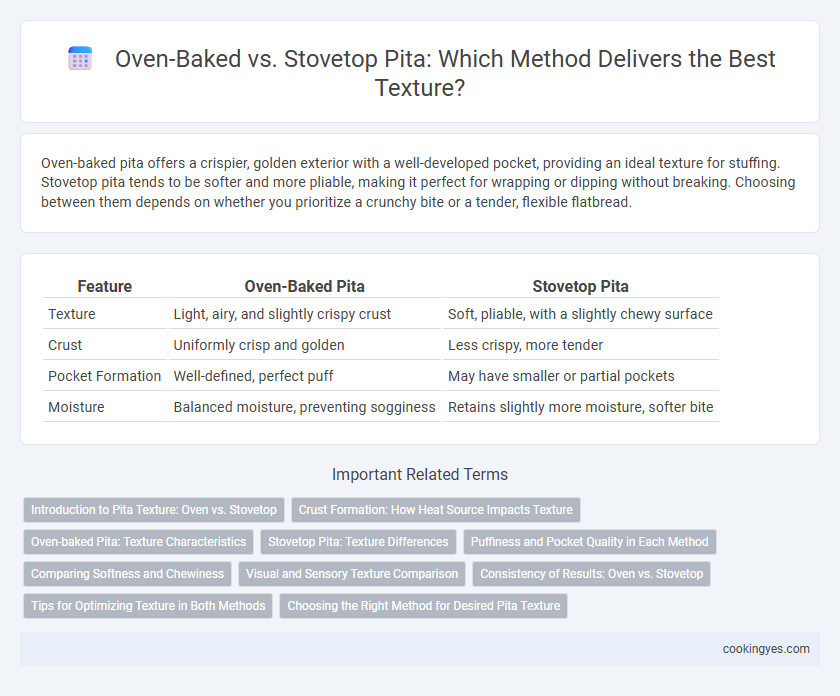Oven-baked pita offers a crispier, golden exterior with a well-developed pocket, providing an ideal texture for stuffing. Stovetop pita tends to be softer and more pliable, making it perfect for wrapping or dipping without breaking. Choosing between them depends on whether you prioritize a crunchy bite or a tender, flexible flatbread.
Table of Comparison
| Feature | Oven-Baked Pita | Stovetop Pita |
|---|---|---|
| Texture | Light, airy, and slightly crispy crust | Soft, pliable, with a slightly chewy surface |
| Crust | Uniformly crisp and golden | Less crispy, more tender |
| Pocket Formation | Well-defined, perfect puff | May have smaller or partial pockets |
| Moisture | Balanced moisture, preventing sogginess | Retains slightly more moisture, softer bite |
Introduction to Pita Texture: Oven vs. Stovetop
Oven-baked pita develops a crisp, golden crust with a pocket that puffs up evenly due to consistent high heat, enhancing its chewy yet tender texture. Stovetop pita offers a softer, more pliable texture with subtle charring and slight blistering, promoting a rustic, handmade feel. Both methods influence the pita's moisture retention and structural integrity, shaping the eating experience and suitability for various fillings.
Crust Formation: How Heat Source Impacts Texture
Oven-baked pita develops a thicker, crispier crust due to the consistent, intense radiating heat that promotes Maillard reaction and caramelization on the surface. Stovetop pita, exposed to direct contact heat, often has a softer, more pliable crust with occasional blistering but less uniform crispness. The heat source fundamentally alters moisture evaporation rates and crust structure, resulting in distinctly textured pitas.
Oven-baked Pita: Texture Characteristics
Oven-baked pita features a crisp, golden exterior with a slightly chewy crumb, achieved through high, even heat that puffs the dough, creating an airy pocket. This method produces a more consistent texture compared to stovetop pita, which tends to be softer and less evenly cooked. The dry heat of the oven enhances Maillard reactions, contributing to a richer flavor and a firmer crust.
Stovetop Pita: Texture Differences
Stovetop pita offers a uniquely soft and pliable texture with slightly charred spots that enhance its flavor profile, contrasting with the crispier and drier crust typically found in oven-baked pita. The direct heat from the stovetop creates steam pockets inside the dough, resulting in a tender interior and flexible outer layer optimal for wraps and dips. This method preserves moisture better, making stovetop pita ideal for dishes requiring soft, foldable bread.
Puffiness and Pocket Quality in Each Method
Oven-baked pita typically achieves superior puffiness due to the consistent high heat, creating a well-defined pocket ideal for stuffing. Stovetop pita, while softer and more flexible, often results in less pronounced pockets with a chewier texture. The oven method favors uniform rise and crisp outer layers, whereas stovetop yields a more rustic, slightly charred finish, impacting pocket formation.
Comparing Softness and Chewiness
Oven-baked pita typically has a firmer crust with a slightly drier texture, resulting in a chewier bite that holds well when stuffed with fillings. Stovetop pita, by contrast, often produces a softer and more pliable texture due to quicker cooking times and retained moisture. The choice between oven-baked and stovetop pita directly affects the softness and chewiness, influencing the overall eating experience depending on preferred texture.
Visual and Sensory Texture Comparison
Oven-baked pita features a golden-brown, crispy exterior with a light, airy interior that boasts a satisfying crunch upon biting. Stovetop pita offers a softer, more pliable texture with subtle char marks and a tender chew, enhancing its flexibility for folding. Visually, oven-baked pita displays a more uniform puffed appearance, while stovetop pita shows uneven bubbles and a slightly rustic finish.
Consistency of Results: Oven vs. Stovetop
Oven-baked pita delivers consistent texture with evenly puffed pockets due to uniform heat circulation, ensuring each bread maintains its characteristic softness and slight chew. Stovetop pita can vary in texture, often resulting in uneven browning and inconsistent pocket formation because of direct, localized heat. For reliable results, ovens provide a more controlled environment, enhancing the pita's quality across multiple batches.
Tips for Optimizing Texture in Both Methods
Oven-baked pita develops a crisp exterior with a soft, airy interior by baking at high temperatures (450-500degF) on a hot stone or steel. For stovetop pita, maintaining medium-high heat and flipping frequently prevents burning while achieving a tender, slightly chewy texture with characteristic puffing. To optimize texture in both methods, allow dough to rest for 30 minutes before cooking and avoid overworking to maintain elasticity and air pocket formation.
Choosing the Right Method for Desired Pita Texture
Oven-baked pita develops a crisp outer crust with a soft, airy interior, ideal for those who prefer a slightly crunchy texture. Stovetop pita produces a chewier, more pliable bread with traditional pocket formation, perfect for wraps and sandwiches. Choosing the right cooking method depends on whether a crispy or tender texture is desired in the final pita.
Oven-baked pita vs Stovetop pita for texture Infographic

 cookingyes.com
cookingyes.com